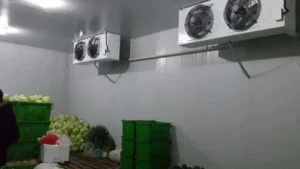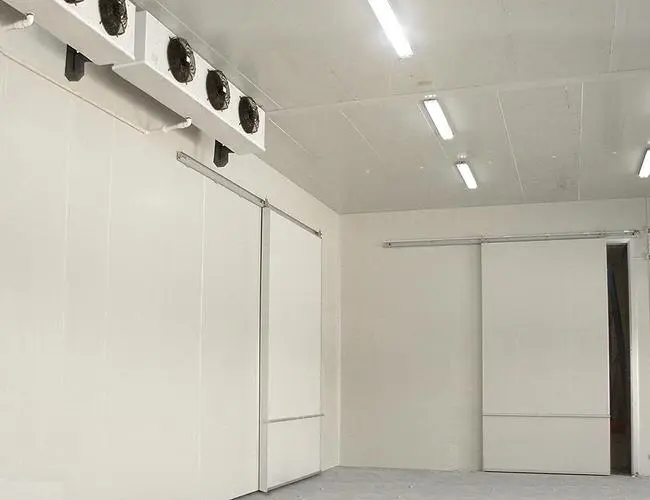Chłodnia jest istotnym elementem wielu gałęzi przemysłu, np. spożywczego, farmaceutyki, placówki medyczne, a także istotną część wielu przedsiębiorstw, w tym restauracje, supermarkety, i precyzyjną elektronikę.
Pomagają zachować świeżość towarów łatwo psujących się, zapewnienie, że pozostają one bezpieczne do spożycia lub stosowania. Jednakże, Efektywność chłodni w dużej mierze zależy od jej temperatury. Jeśli temperatura jest za wysoka lub za niska, może to spowodować zepsucie, marnować, i potencjalne zagrożenia dla zdrowia.
Dlatego, istotne jest utrzymanie optymalnej temperatury w chłodni. W tym przewodniku, omówimy wszystko, co musisz wiedzieć o temperaturze w chłodni.
Co to jest chłodnia?
A zimny pokój to zamknięta przestrzeń zaprojektowana w celu utrzymania określonego zakresu temperatur do przechowywania produktów łatwo psujących się, takich jak żywność, szczepionki, farmaceutyki, itp. Jest to chłodnia o izolowanych ścianach, podłogi, i sufity zapewniające stabilność temperatury.

Jaka jest optymalna temperatura w chłodni?
Optymalna temperatura w chłodni w dużej mierze zależy od rodzaju przechowywanego produktu. Oto kilka ogólnych wskazówek:
Świeże produkty: 32~40°F (0~4°C)
Mięso i drób: 28~32°F (-2~0°C)
Zamrożone jedzenie: <0° F (-18°C)
Szczepionki i leki: 35~46°F (2~8°C)
Dlaczego odpowiednia temperatura w chłodni jest ważna?
Utrzymanie właściwej temperatury w chłodni jest krytyczne z kilku powodów:
Zapewnij bezpieczeństwo żywności
Komory chłodnicze służą głównie do przechowywania towarów łatwo psujących się, łącznie z jedzeniem. Jeśli temperatura jest zbyt wysoka, bakterie mogą szybko się rozwijać, prowadzące do psucia się żywności i potencjalnego zagrożenia dla zdrowia.
Zmniejszenie ilości odpadów
Gdy temperatura jest za wysoka lub za niska, może spowodować szybkie zepsucie się żywności, powodując marnotrawstwo i straty finansowe.
Przestrzegaj Regulaminu
FDA i inne organy regulacyjne ustaliły wytyczne dotyczące temperatur w chłodniach, których przedsiębiorcy muszą przestrzegać.
Efektywności energetycznej
Utrzymanie odpowiedniej temperatury może również pomóc w oszczędzaniu energii i obniżeniu kosztów.
Jakość produktu
Właściwy zakres temperatur pomoże zachować jakość produktów, smak, i wartość odżywcza.
Utrzymuj optymalną temperaturę w chłodni
Regularne monitorowanie temperatury
Regularne monitorowanie temperatury w chłodni jest niezbędne. Można to zrobić za pomocą termometru lub automatycznego systemu monitorowania, który ostrzega, gdy temperatura przekroczy ustawiony zakres.
Sposoby monitorowania temperatury w chłodni
Istnieją różne sposoby monitorowania temperatury w chłodni, a wybór właściwej drogi zależy od kilku czynników, łącznie z wielkością pokoju, rodzaj przechowywanego produktu, i wymagania regulacyjne. Oto kilka typowych sposobów monitorowania temperatury w chłodni:
1). Ręczne monitorowanie temperatury
Za pomocą termometru lub dziennika temperatury sprawdzić temperaturę w chłodni.
Ten sposób jest niedrogi i prosty, wymaga to jednak stałego monitorowania przez przeszkolony personel, co może być czasochłonne i podatne na błędy ludzkie.

Termometr do chłodni
2). Automatyczne monitorowanie temperatury
Używanie czujników i rejestratorów danych do ciągłego monitorowania temperatury w chłodni.
Czujniki i rejestratory danych można podłączyć do systemu monitorowania, który ostrzega personel, gdy temperatura odbiega od optymalnego zakresu. Ten sposób jest bardziej niezawodny i wydajny niż monitorowanie ręczne, i może zaoszczędzić czas i zmniejszyć ryzyko błędu ludzkiego.
3). Bezprzewodowe monitorowanie temperatury
Wykorzystanie czujników bezprzewodowych i systemu monitoringu do monitorowania temperatury w chłodni.
Czujniki bezprzewodowe można umieścić w różnych miejscach chłodni, a dostęp do danych można uzyskać zdalnie za pomocą komputera lub urządzenia mobilnego. Taki sposób jest wygodny i pozwala na monitorowanie w czasie rzeczywistym, co może pomóc w szybkiej identyfikacji odchyleń temperatury.
TU SĄ kilka najlepszych praktyk w zakresie skutecznego monitorowania temperatury w chłodni:
1). Zdefiniuj zakresy i limity temperatur
Informacje te można uzyskać ze specyfikacji produktu lub wymogów prawnych. Po określeniu zakresu temperatur i limitów, system monitorowania można skonfigurować tak, aby ostrzegał personel, gdy temperatura odbiega od optymalnego zakresu.
2). Kalibracja czujników i rejestratorów danych
Czujniki i rejestratory danych należy regularnie kalibrować, aby zapewnić dokładne odczyty temperatury. Kalibracja polega na porównaniu odczytów czujników i rejestratorów danych ze skalibrowanym termometrem, aby upewnić się, że mieszczą się one w akceptowalnym zakresie.
3). Przeprowadzaj regularne kontrole konserwacyjne
Należy przeprowadzać regularne kontrole konserwacyjne systemu monitorowania, czujniki, i rejestratory danych, aby zapewnić ich prawidłowe działanie. Wszelkie nieprawidłowo działające urządzenia należy natychmiast naprawić lub wymienić, aby zapobiec wahaniom temperatury.
Wybór odpowiedniego sposobu zależy od kilku czynników, należy przestrzegać najlepszych praktyk, aby zapewnić dokładne i niezawodne monitorowanie temperatury.
Właściwa izolacja
Izolacja odgrywa kluczową rolę w utrzymaniu właściwej temperatury w chłodni. Upewnij się, że chłodnia jest odpowiednio izolowana, łącznie ze ścianami, sufit, i podłoga.
TU SĄ kilka kroków, które możesz podjąć, aby zapewnić odpowiednią izolację:
1). Ocenić obecną izolację
Pierwszy, oceń obecną izolację w swojej chłodni. Sprawdź, czy nie występują oznaki zużycia, luki, lub uszkodzenie. Sprawdź ściany, podłogi, i sufit.
2). Wybierz odpowiedni materiał izolacyjny
Wybierz odpowiedni materiał izolacyjny w oparciu o wymagania temperaturowe Twoich produktów i lokalny klimat. Typowe materiały obejmują: poliuretan, polistyren, włókno szklane, i wełnę skalną.

poliuretan (PU) Płyta
3). Zainstaluj izolację
Zaizoluj ściany, podłogi, i sufit chłodni z wybranego materiału. Upewnij się, że izolacja jest prawidłowo zainstalowana i pokrywa wszystkie obszary chłodni.
4). Uszczelnij szczeliny i pęknięcia
Uszczelnij wszelkie szczeliny i pęknięcia w izolacji za pomocą masy uszczelniającej lub pianki uszczelniającej. Zapobiega to przenoszeniu ciepła z otoczenia zewnętrznego i utrzymuje pożądany zakres temperatur.
5). Zainstaluj odizolowanie pogodowe
Zainstaluj listwy uszczelniające wokół drzwi i okien chłodni, aby zapobiec przedostawaniu się ciepłego powietrza i ucieczce zimnego powietrza.
6). Regularnie konserwuj izolację
Regularnie konserwuj izolację, czyszcząc jej powierzchnie, sprawdzając, czy nie ma uszkodzeń lub luk, i naprawić lub wymienić, jeśli to konieczne.
Regularna konserwacja
Regularna konserwacja chłodni jest niezbędna, aby zapewnić jej optymalne funkcjonowanie. Obejmuje to czyszczenie cewek i wentylatorów, sprawdzanie wycieków, i wymianę wszelkich wadliwych części.
Prawidłowe ładowanie
Właściwe obciążenie chłodni jest niezbędne, aby zapewnić prawidłową cyrkulację powietrza i stałą temperaturę. Przeciążenie lub zablokowanie przepływu powietrza może prowadzić do powstawania gorących punktów i wahań temperatury.

Zostaw drzwi zamknięte
Upewnij się, że drzwi do chłodni są jak najbardziej zamknięte, aby zapobiec przedostawaniu się ciepłego powietrza i ucieczce zimnego powietrza.
Użyj alarmu temperatury
Używaj alarmów temperatury, które ostrzegają Cię, gdy temperatura w chłodni wykracza poza pożądany zakres. Pozwala to na szybkie podjęcie działań i zapobiegnięcie uszkodzeniom przechowywanych produktów.
Właściwe oświetlenie
Używaj odpowiedniego oświetlenia w chłodni, ponieważ nadmierne ciepło pochodzące od oświetlenia może mieć wpływ na temperaturę. Używaj energooszczędnego oświetlenia LED, które wytwarza minimalną ilość ciepła.
Właściwe regały
W chłodni należy stosować regały umożliwiające prawidłową cyrkulację zimnego powietrza. Unikaj przepełnienia półek, które mogą blokować przepływ powietrza i powodować wahania temperatury.
Właściwy poziom wilgotności
Monitoruj poziom wilgotności w chłodni, ponieważ wysoka wilgotność może prowadzić do kondensacji i uszkodzenia przechowywanych produktów. Użyć Osuszacz powietrza jeśli to konieczne, aby utrzymać odpowiedni poziom wilgotności.

Komercyjny osuszacz
Zoptymalizuj przepływ powietrza
Zoptymalizuj przepływ powietrza w chłodni, układając produkty tak, aby zapewnić odpowiednią cyrkulację zimnego powietrza. Może to pomóc w utrzymaniu stałej temperatury w całym pomieszczeniu.
Właściwe opakowanie
Do produktów przechowywanych w chłodni należy używać odpowiedniego opakowania, takie jak izolowane pojemniki lub opakowania z izolacją termiczną. Pomoże to w utrzymaniu żądanej temperatury i zabezpieczy produkty przed uszkodzeniem.
Najlepsze praktyki w zakresie utrzymywania optymalnej temperatury w chłodni
Używaj energooszczędnego sprzętu
Inwestycja w energooszczędny sprzęt może pomóc obniżyć koszty energii i utrzymać odpowiednią temperaturę w chłodni. Obejmuje to użycie oświetlenia LED, wydajne sprężarki, i wysokiej jakości izolacja.

Kompresor Copelanda
Personel pociągu
Niezbędne jest odpowiednie przeszkolenie personelu w zakresie znaczenia utrzymywania właściwej temperatury i sposobów jej wykonywania. Obejmuje to nauczenie ich, jak prawidłowo załadować chłodnię, jak monitorować temperaturę, i jak zgłaszać wszelkie problemy.
Plan zastępczy
Mogą wystąpić przerwy w dostawie prądu lub awarie sprzętu, które mogą mieć wpływ na temperaturę w chłodni. Posiadanie planu zapasowego, takie jak generator zapasowy lub plan przeniesienia elementów do innej lokalizacji, może pomóc zminimalizować wpływ.
Wniosek
Utrzymanie właściwej temperatury w chłodni ma kluczowe znaczenie dla zapewnienia jakości produktu, zapobiec zepsuciu, i przestrzegać przepisów.
Wymaga regularnego monitorowania, odpowiednią izolację, konserwacja, i ładowanie. Inwestycja w energooszczędny sprzęt, szkolenie personelu, oraz posiadanie planu awaryjnego to podstawowe najlepsze praktyki w zakresie utrzymywania temperatury w chłodni. Przestrzeganie tych wskazówek pomoże zapewnić, że Twoje produkty pozostaną świeże i wysokiej jakości.
Wszelkie uwagi?
Witamy zostaw wiadomość lub opublikuj ponownie.



